Terry L. Ettinger Horticulture Consulting Services
Meeting The Needs Of Today With A Vision For The Future
Recommended Trees -
River Birch
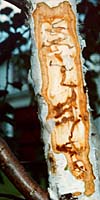 White-barked birches have long been desired as medium-sized ornamental trees in landscapes across North America.
Unfortunately, the two most common white-barked species, European
birch and our native paper birch, are both very susceptible to fatal
infestations of Bronze Birch borer.
White-barked birches have long been desired as medium-sized ornamental trees in landscapes across North America.
Unfortunately, the two most common white-barked species, European
birch and our native paper birch, are both very susceptible to fatal
infestations of Bronze Birch borer.
"Girdling" damage caused by the larval stage of this pest can be seen in the picture at right. Infested white-barked birch trees gradually die from the top down, below left.
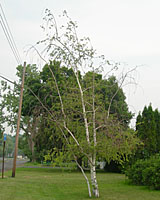 Unlike the white-barked birches, River Birch (Betula nigra), is resistant to bronze birch borer infestation. It's also
very tolerant of the poorly drained, clay soils found in many Central New York neighborhoods.
Unlike the white-barked birches, River Birch (Betula nigra), is resistant to bronze birch borer infestation. It's also
very tolerant of the poorly drained, clay soils found in many Central New York neighborhoods.
In fact, throughout its native range from New Hampshire to Florida, and west to all of the states bordering the Mississippi river, river birch is often found growing in lowlands adjacent to rivers that flood frequently - hence, the name "river" birch.
I'm particularly familiar with stands of river birch growing on islands in the Mississippi river near LaCrosse, Wisconsin. On several occasions, I've seen these trees thriving in June - even though the islands were under ten to twenty feet of flood water!
River birch has several characteristics that make it a perfect match for Central New York landscapes.
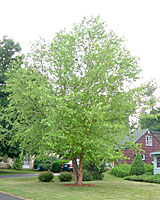 First
is, again, its tolerance of heavy, poorly draining clay soils. As
mentioned above, it can even tolerate periods of standing water
caused by snow melt or torrential summer rainstorms.
First
is, again, its tolerance of heavy, poorly draining clay soils. As
mentioned above, it can even tolerate periods of standing water
caused by snow melt or torrential summer rainstorms.
It also grows quickly, possibly up to two feet per year once established. And, while it can grow more than 100 feet tall in the rich soils along the Mississippi river, it matures at about fifty feet in landscape settings as either a single, or multiple-trunked tree, at right.
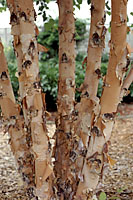 In addition to its pest-resistance, the characteristic that particularly attracts me to this tree is its bark.
In addition to its pest-resistance, the characteristic that particularly attracts me to this tree is its bark.
On trees up to five or so years old, the bark is reddish-bronze. As the tree continues to mature, the bark gradually starts pealing into paper-like sheets revealing colors ranging from bronze, to cinnamon, to tan and even creamy white, at left.
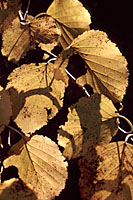 Surrounded
by a layer of its own golden leaves, at right, on an emerald
green lawn in mid-autumn, draped with new-fallen snow throughout the
winter or set against a backdrop of evergreens, the bark of this tree is simply spectacular throughout the year!
Surrounded
by a layer of its own golden leaves, at right, on an emerald
green lawn in mid-autumn, draped with new-fallen snow throughout the
winter or set against a backdrop of evergreens, the bark of this tree is simply spectacular throughout the year!
The most common cultivar (i.e., "cultivated variety") of river birch is `Heritage,' which tends to have a slightly more paper-like and colorful bark than the species.
I've also been very impressed with a "dwarf" (but not small) river birch form, `Little King' (Betula nigra `Fox Valley').
Reported to mature at roughly twenty feet in height and width and with the same beautiful bark characteristics of the species, I've seen it used as a hedging plant at the Missouri Botanical Garden in St. Louis (but, unfortunately, didn't have a camera in hand at the time). At this size, `Little King' river birch could be fit into even very small, urban landscape settings!